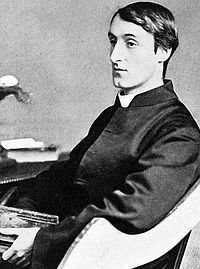Gerard Manley Hopkins
|
The Reverend Gerard Manley Hopkins SJ |
|
|---|---|
 |
|
| Orders | |
| Ordination | September 1877 |
| Personal details | |
| Born |
28 July 1844 Stratford, Essex, England |
| Died | 8 June 1889 (aged 44) Dublin, County Dublin, Ireland |
| Buried | Glasnevin Cemetery, Dublin |
| Nationality | British |
| Denomination | Roman Catholic |
| Occupation | Poet, Jesuit priest, Professor of Classics |
| Alma mater |
Highgate School, London Balliol College, Oxford |
Gerard Manley Hopkins SJ (28 July 1844 – 8 June 1889) was an English poet, convert to Catholicism, and Jesuit priest, whose posthumous fame established him among the leading Victorian poets. His manipulation of prosody (particularly his invention of sprung rhythm) and his use of imagery established him after his death as an innovative writer of verse. Nature and religion were the two major themes in his poetic works.
Gerard Manley Hopkins was born in Stratford, Essex (now in Greater London), as the first of nine children to Manley and Catherine (Smith) Hopkins. He was christened at the Anglican church of St John's, Stratford. His father founded a marine insurance firm and, at one time, served as the Hawaiian consul general in London. He was also, for a time, the church warden at St John-at-Hampstead. His grandfather was the physician John Simm Smith, university colleague of John Keats, and close friend of the eccentric philanthropist Ann Thwaytes.
A poet, Hopkins' father published works including A Philosopher's Stone and Other Poems (1843), Pietas Metrica (1849), and Spicelegium Poeticum, A Gathering of Verses by Manley Hopkins (1892). He reviewed poetry for The Times and wrote one novel. Catherine (Smith) Hopkins was the daughter of a London physician, particularly fond of music and of reading, especially German philosophy, literature and the novels of Dickens. Both parents were deeply religious High Church Anglicans. Catherine's sister, Maria Smith Giberne, taught her nephew Gerard to sketch. The interest was supported by his uncle, Edward Smith, his great-uncle Richard James Lane, a professional artist, and many other family members. Hopkins's first ambitions were to be a painter, and he would continue to sketch throughout his life, inspired, as an adult, by the work of John Ruskin and the Pre-Raphaelites.
...
Wikipedia
